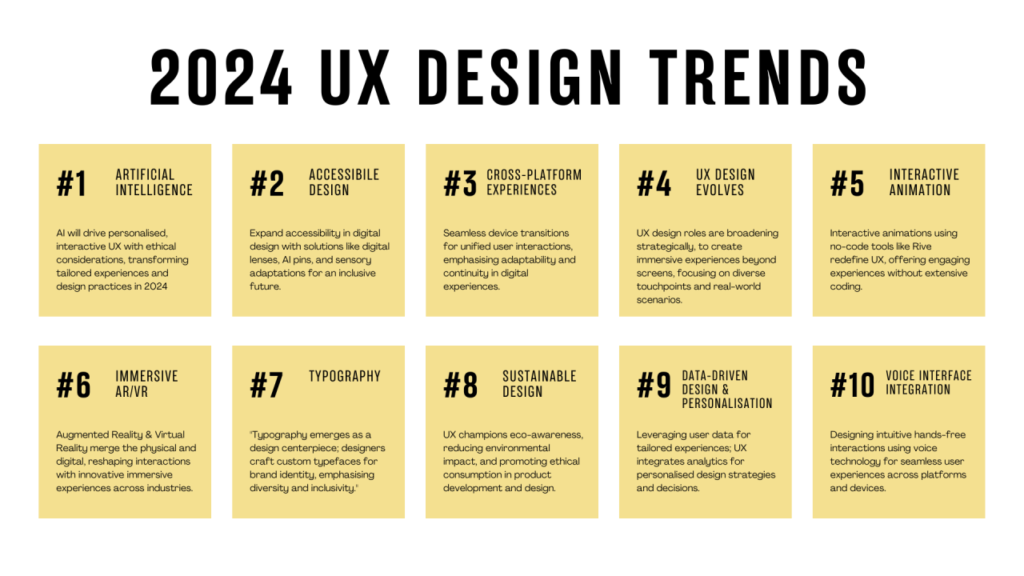As technology continues to evolve at a rapid pace, so too does the landscape of user experience (UX) design. In 2024, we’re witnessing exciting innovations and shifts in UX trends that promise to revolutionize how users interact with digital products and services. In this blog post, we’ll explore some of the top UX trends shaping the industry in 2024 and how businesses can leverage them to create exceptional user experiences.
- Immersive Experiences with Extended Reality (XR):
With the advancement of augmented reality (AR) and virtual reality (VR) technologies, immersive experiences are becoming more accessible and mainstream. In 2024, we anticipate seeing an increase in the integration of XR technology into various digital products and services, from e-commerce and entertainment to education and healthcare. Businesses can leverage XR to create interactive and engaging experiences that blur the lines between the physical and digital worlds, providing users with new ways to explore and interact with content. - Voice User Interfaces (VUIs) and Conversational UX:
The proliferation of voice-enabled devices and virtual assistants has led to the rise of voice user interfaces (VUIs) and conversational UX. In 2024, we expect to see a continued emphasis on designing intuitive and natural language interactions across various platforms and devices. Businesses can leverage VUIs to streamline user interactions, enhance accessibility, and provide personalized experiences through voice commands and natural language processing. - Ethical Design and User Privacy:
With growing concerns about data privacy and digital ethics, ethical design principles are becoming increasingly important in UX design. In 2024, businesses will need to prioritize user privacy and transparency by implementing robust data protection measures, providing clear consent mechanisms, and adhering to ethical design standards. Designing with empathy and inclusivity will be key to building trust with users and fostering positive relationships. - Hyper-Personalization and Predictive UX:
As data analytics and machine learning capabilities continue to advance, hyper-personalization and predictive UX are poised to become prevalent trends in 2024. By leveraging user data and behavioral insights, businesses can deliver personalized experiences tailored to individual preferences, needs, and context. Predictive UX algorithms can anticipate user intent, anticipate needs, and proactively offer relevant content and recommendations, enhancing user satisfaction and engagement. - Accessibility-First Design:
Accessibility is no longer an afterthought but a fundamental aspect of UX design. In 2024, businesses will increasingly prioritize accessibility-first design principles to ensure that digital products and services are inclusive and accessible to users of all abilities. This includes designing with accessibility features in mind, such as screen readers, keyboard navigation, and color contrast, as well as conducting regular accessibility audits and user testing to identify and address barriers to accessibility. - Minimalism and Simplified Design:
In an age of information overload, minimalist and simplified design principles are gaining traction in 2024. Streamlined interfaces, clean layouts, and intuitive navigation are becoming increasingly popular as users seek clarity and efficiency in their digital experiences. Businesses can embrace minimalist design trends to reduce cognitive load, improve usability, and create memorable user experiences that prioritize content and functionality. - Emotional Design and Empathetic Experiences:
Emotional design is emerging as a powerful tool for creating meaningful connections with users in 2024. By designing with empathy and understanding users’ emotional needs and motivations, businesses can create experiences that resonate on a deeper level and foster positive emotions. From microinteractions and animations to tone of voice and brand storytelling, emotional design elements can evoke joy, trust, and loyalty, ultimately driving user engagement and brand affinity.
In conclusion, the landscape of UX design is evolving rapidly, driven by technological advancements, changing user expectations, and a growing emphasis on ethics and inclusivity. By embracing these top UX trends for 2024 and prioritizing user-centric design principles, businesses can create exceptional digital experiences that delight users, drive engagement, and stay ahead of the curve in an increasingly competitive landscape.
